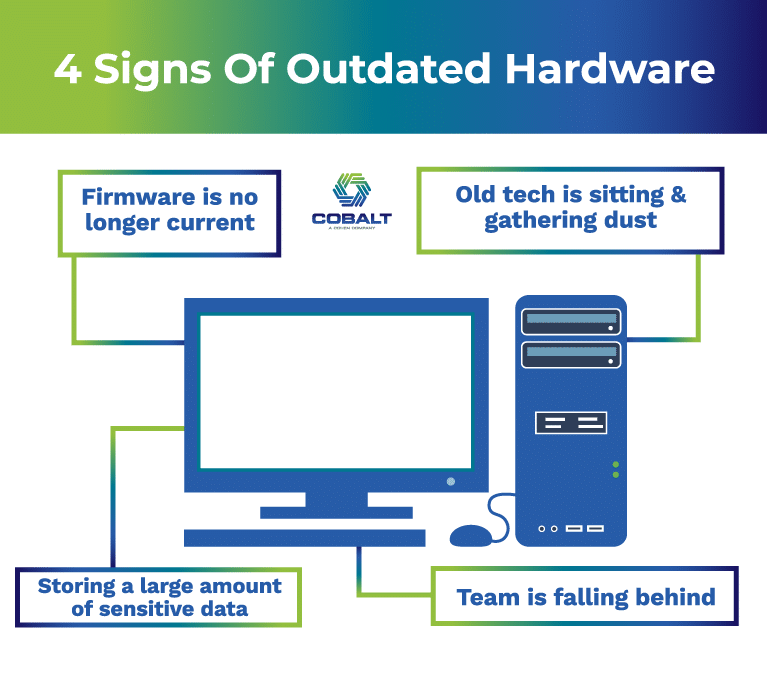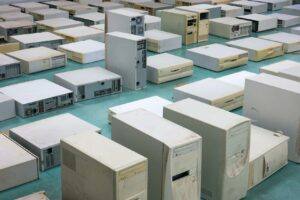The pace of advancement in IT can sometimes surge ahead of the pace of business. As a result, companies may find themselves using and relying on hardware equipment – computers, laptops, network switches, and servers, for example – that’s become outdated, practically overnight.
So what? You might ask. Does “latest” always mean “greatest”? Besides, didn’t we just upgrade our system a few years ago?
While it might not seem like a big deal to keep using equipment that isn’t fresh off the shelf, it can introduce risks to your company’s data and brand. Motivated hackers and other bad actors know how to exploit security flaws in outdated hardware, software, and firmware.
If you think system-wide upgrades are costly and inconvenient, try dealing with a data breach. What’s more, you could actually be leaving money on the table by letting old equipment sit unused in storage. Read on for some signs that it could be time to hit the Refresh button on your IT lifecycle.

Your Firmware is No Longer Current
The issue with outdated equipment often isn’t the physical device itself, but its firmware. Firmware is a layer of permanent programming that functions alongside the operating system on most devices. As the name implies, it’s a sort of mediator between hardware and software. It’s also the piece that is most likely to cause issues the longer a device is in use, but because it is built into the device itself, it can’t just be easily swapped out or updated.
Outdated firmware can, however, become a serious liability. Because it runs in the background and is easily overlooked, it’s an attractive target for hackers. And as the “Internet of Things” adds more and more devices, this vulnerability also multiplies: every so-called smart device relies on firmware to function.
It’s unfortunately very likely that your firmware could be out of date and at risk without you even knowing it. More than a third of companies don’t even scan for such risks.
You’re Storing a Lot of Sensitive Data
Employee files and payroll data. Customer accounts and records. Invoices and bank statements. Credit card and Social Security numbers. Proprietary knowledge and confidential trade information. Internal communications that were never meant to be seen by prying eyes.
Your IT assets are a goldmine for data that could seriously harm your business. Your brand’s reputation, your employees and customers, and even your vendors and partners could be exposed to significant risk in the event of a breach. The longer you wait to upgrade, the more you are gambling with that risk. Just ask Equifax: their highly publicized 2017 data breach was the result of a vulnerability that was known about for nine years.
Even assets that have been taken offline and are no longer in use can become liabilities if they’re not properly decommissioned. Most companies focus their resources on the security of their live assets without making a plan for their retired ones. Electronics recycling and secure IT asset disposition (ITAD) need to be taken just as seriously as live viruses and hackers.
Your Team is Falling Behind
A business that relies on technology to stay competitive can easily lose its edge if it doesn’t keep up with the latest products on the market. Whether you use technology to directly service clients and customers, or to keep your back-end operations running smoothly – and likely, it’s both – outdated systems can slow you down.
Common productivity pitfalls include:
- Unreliable phone systems that drop or lose connectivity
- Point of sale systems that slow down customer transactions
- Outdated computers & laptops with slow operating systems
- Insufficient memory, storage space, or hardware (e.g., video cards) to run powerful programs
If you and your colleagues often find yourselves tapping your fingers while waiting for something to load, having to use creative workarounds to get technology to cooperate, or restarting after yet another unexpected crash… it’s probably time for an upgrade.
Your Old Tech is Gathering Dust – Literally
In your career, you’ve probably seen at least one: a room, a basement, or a closet full of old computers, monitors, keyboards, printers, server racks, fax machines, you name it – tucked safely out of sight and out of mind, to be dealt with some other day.
Surprise! Letting those assets gather dust is leaving money on the table.
You might be thinking, Didn’t you just get done telling me that old IT equipment is useless? Not quite. It’s true that you might be done using it, but that doesn’t mean it has no use – or no value. You can do one of three things with old electronics:
- Refurbish and remarket: Equipment that is only a few years old or gently used can usually be restored to working order and sold on the secondhand market.
- Recover usable parts: Components such as circuit boards, processors, motors, and heat sinks have resale value that might be better than the whole unit.
- Recycle as scrap: Rarely, something is truly at the end of its useful life, at which point it can still be shredded and sorted into commodities that are then put back into the manufacturing supply chain, to be used in making new products.
Practically all electronics can be recycled through one of these three methods. As long as there is a secure, documented data destruction protocol in place, there’s actually less risk to recycling your equipment than there is in keeping it online.
Why Choose Cobalt?
Cobalt was founded by recyclers, and we firmly believe that reuse is the best form of recycling. Reuse not only delivers maximum value back to your business, it’s the most sustainable decision for the planet. There’s no reason to ever send electronics to a landfill.
Choose Cobalt to help you do the right thing with your IT assets. We run our own refurbishment and remarketing lab and offer revenue-sharing and rebate programs to get you the best possible return on your hardware. It’s all backed by certified data destruction protocols that eliminate all data security risks and document the entire process, for your peace of mind.
Learn more about Cobalt’s remarketing and refurbishing processes here.





